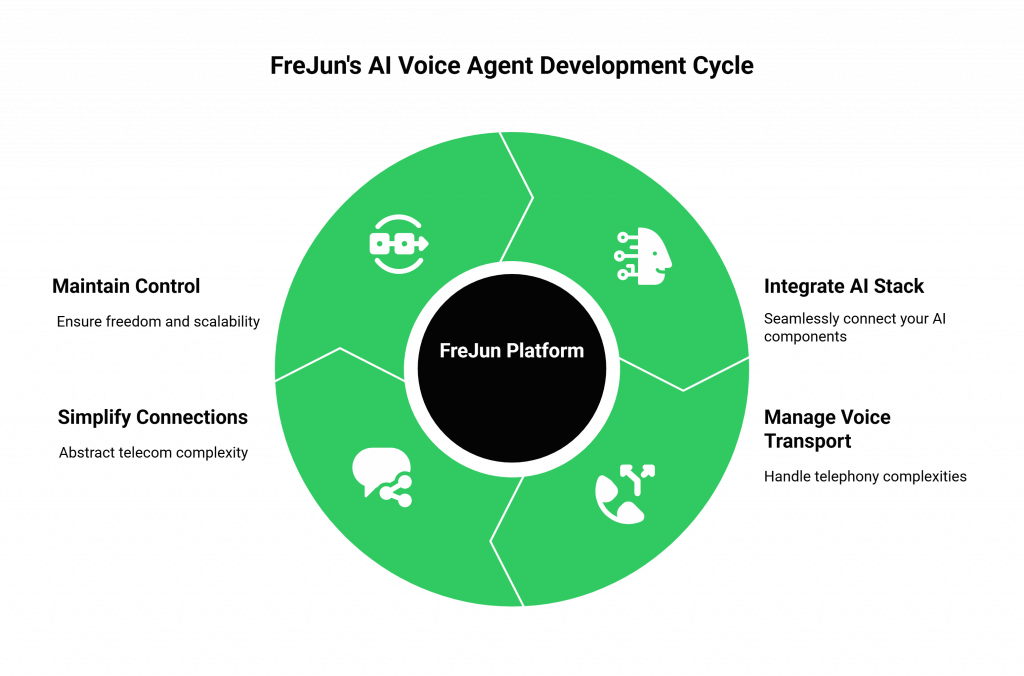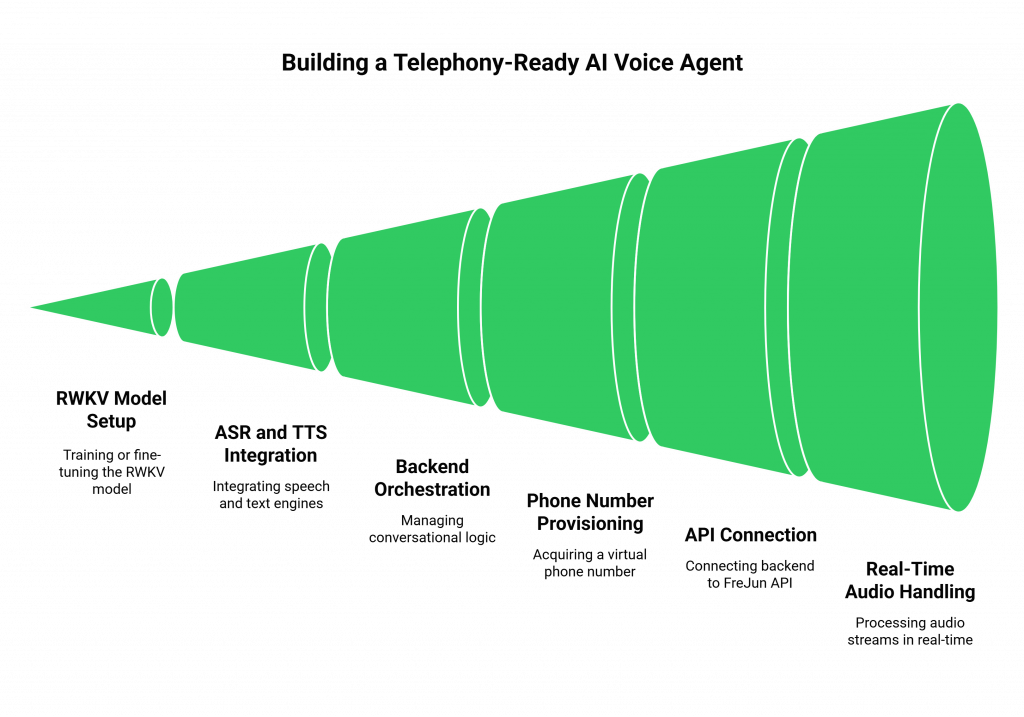The world of conversational AI is undergoing a seismic shift, driven by the rise of innovative, open architectures. For developers, this represents a new era of freedom and control. Instead of being locked into a single proprietary ecosystem, they can now build highly customized conversational experiences using novel models.
The opportunity to build AI voice agents using RWKV, a unique architecture combining the strengths of RNNs and Transformers, is a prime example of this new frontier. It offers a path to create a truly unique and powerful “brain” for your business.
Table of contents
- What Makes AI Voice Agents Using RWKV So Compelling?
- The Hidden Challenge: A Brilliant Bot Trapped in Your Data Center
- FreJun: The Voice Infrastructure Layer for Your Custom AI Agent
- DIY Telephony vs. A FreJun-Powered Agent: A Strategic Comparison
- How to Build a Telephony-Ready AI Voice Agent with RWKV?
- Best Practices for a Flawless Implementation
- Final Thoughts
- Frequently Asked Questions (FAQ)
This freedom is intoxicating. You can handpick your entire AI stack, pairing RWKV’s advanced language processing with best-in-class speech recognition and synthesis engines, to create a bespoke conversational experience. However, after the initial success of building this intelligent core, many teams run into a formidable and often project-killing roadblock. Their brilliant, custom-built creation is trapped, unable to connect to the most critical channel for any real-world business application: the telephone network.
What Makes AI Voice Agents Using RWKV So Compelling?
RWKV (Receptance Weighted Key Value) is not just another language model; it’s a fundamentally different architecture that offers a unique combination of performance and efficiency. This makes it ideal for custom voice agents. Key features include:
- Ultimate Customization and Control: You can fine-tune RWKV models on your own data, giving them deep, domain-specific knowledge.
- Efficiency and Performance: By combining the parallelizability of Transformers with the efficiency of RNNs, RWKV can handle long context sequences with linear time and memory complexity. This is a significant advantage for real-time, multi-turn voice conversations.
- A Best-in-Class Stack: You have the freedom to assemble a “dream team” of components, pairing RWKV’s powerful NLU with other best-of-breed open-source or commercial tools for Automatic Speech Recognition (ASR) and Text-to-Speech (TTS).
This flexibility allows developers to build a truly differentiated AI brain, tailored to their specific needs.
The Hidden Challenge: A Brilliant Bot Trapped in Your Data Center
You have successfully built your custom AI stack. Your RWKV-powered agent is intelligent, context-aware, and works perfectly in your development environment. Now, it’s time to put it to work. Your business needs it to handle the customer support hotline, qualify sales leads, or automate appointment booking over the phone.
This is where the project grinds to a halt. The problem is that the entire ecosystem of tools used to build your bot, RWKV, Whisper for ASR, a custom TTS engine, is designed to process data, not to manage live phone calls. To connect your custom-built agent to the Public Switched Telephone Network (PSTN), you would have to build a highly specialized and complex voice infrastructure from scratch. This involves solving a host of non-trivial engineering challenges:
- Telephony Protocols: Managing SIP (Session Initiation Protocol) trunks and carrier relationships.
- Real-Time Media Servers: Building and maintaining dedicated servers to handle raw audio streams from thousands of concurrent calls.
- Call Control and State Management: Architecting a system to manage the entire lifecycle of every call, from ringing and connecting to holding and terminating.
- Network Resilience: Engineering solutions to mitigate the jitter, packet loss, and latency inherent in voice networks that can destroy the quality of a real-time conversation.
Suddenly, your AI project has become a grueling telecom engineering project, pulling your team away from its core mission of building an intelligent and effective bot. The freedom you gained by using an innovative architecture is lost in the rigid, complex world of telephony.
FreJun: The Voice Infrastructure Layer for Your Custom AI Agent
This is the exact problem FreJun was built to solve. We are not another AI model or a closed ecosystem. We are the specialized voice infrastructure platform that provides the missing layer, allowing you to connect your custom agent to the telephone network with a simple, powerful API. FreJun is the key to letting you build AI voice agents using RWKV that are both powerful and reachable.

We handle all the complexities of telephony, so you can focus on perfecting your unique AI stack.
- We are AI-Agnostic: You bring your own “brain.” FreJun integrates seamlessly with any backend, allowing you to use your custom RWKV, ASR, and TTS stack.
- We Manage the Voice Transport: We handle the phone numbers, the SIP trunks, the global media servers, and the low-latency audio streaming.
- We are Developer-First: Our platform makes a live phone call look like just another WebSocket connection to your application, abstracting away all the underlying telecom complexity.
With FreJun, you can maintain the full freedom and control of a custom AI stack while leveraging the reliability and scalability of an enterprise-grade voice network.
DIY Telephony vs. A FreJun-Powered Agent: A Strategic Comparison
| Feature | The Full DIY Approach (Including Telephony) | Your Custom RWKV Stack + FreJun |
| Infrastructure Management | You build, maintain, and scale your own voice servers, SIP trunks, and network protocols. | Fully managed. FreJun handles all telephony, streaming, and server infrastructure. |
| Scalability | Extremely difficult and costly to build a globally distributed, high-concurrency system. | Built-in. Our platform elastically scales to handle any number of concurrent calls on demand. |
| Development Time | Months, or even years, to build a stable, production-ready telephony system. | Weeks. Launch your globally scalable voice bot in a fraction of the time. |
| Developer Focus | Divided 50/50 between building the AI and wrestling with low-level network engineering. | 100% focused on building the best possible conversational experience. |
| Maintenance & Cost | Massive capital expenditure and ongoing operational costs for servers, bandwidth, and a specialized DevOps team. | Predictable, usage-based pricing with no upfront capital expenditure and zero infrastructure maintenance. |
How to Build a Telephony-Ready AI Voice Agent with RWKV?
This step-by-step guide outlines the modern, efficient process for taking your custom-built RWKV-powered agent from your local machine to a production-ready telephony deployment.

Step 1: Build Your AI Core
First, assemble your custom AI stack.
- Set up your RWKV Model: Leverage the RWKV GitHub repositories and tools to train or fine-tune your model.
- Integrate ASR and TTS: Install and configure your chosen speech recognition engine (like Whisper or AssemblyAI) and text-to-speech engine (like ElevenLabs or playht).
- Orchestrate with a Backend: Write a backend application (e.g., in Python) that orchestrates these components. This is where you will manage the conversational logic and context.
Step 2: Provision a Phone Number with FreJun
Instead of negotiating with telecom carriers, simply sign up for FreJun and instantly provision a virtual phone number. This number will be the public-facing identity for your AI agent.
Step 3: Connect Your Backend to the FreJun API
In the FreJun dashboard, configure your new number’s webhook to point to your backend’s API endpoint. This tells our platform where to send live call audio and events. Our server-side SDKs make handling this connection simple.
Step 4: Handle the Real-Time Audio Flow
When a customer dials your FreJun number, our platform answers the call and establishes a real-time audio stream to your backend. Your code will then:
- Receive the raw audio stream from FreJun.
- Pipe this audio to your ASR engine to be transcribed.
- Send the transcribed text to your RWKV model for processing.
- Take the AI’s text response and send it to your TTS engine for synthesis.
- Stream the synthesized audio back to the FreJun API, which plays it to the caller with ultra-low latency.
Step 5: Deploy and Monitor Your Solution
Deploy your backend application to a scalable cloud provider, using a GPU-accelerated environment to optimize inference speed. Once live, use monitoring tools to track your bot’s performance, analyze user interactions, and continuously improve its accuracy and effectiveness.
Best Practices for a Flawless Implementation
- Leverage Long Context for Coherence: Take full advantage of RWKV’s ability to handle long context sequences to maintain coherent, multi-turn conversations. This is a key differentiator that allows for a more natural and satisfying user experience.
- Optimize for Low Latency: For a natural conversation, it’s critical to minimize the inference time of your models. Deploy your RWKV model on a GPU-accelerated server and choose ASR and TTS providers that are optimized for speed.
- Design for Human Handoff: No AI is perfect. For complex issues, design a clear path to escalate the conversation to a human agent. FreJun’s API can facilitate a seamless live call transfer.
- Secure Your Data: When you build AI voice agents using RWKV on your infrastructure, you have full control over data privacy. Ensure secure handling of user data and API credentials in compliance with all relevant standards.
Final Thoughts
The freedom to build AI voice agents using RWKV and other innovative open-source models is a revolutionary advantage. It allows you to create a truly unique and differentiated conversational AI experience. But that advantage is lost if your team gets bogged down in the complex, undifferentiated heavy lifting of building and maintaining a global voice infrastructure.
The strategic path forward is to focus your resources where they can create the most value: in the intelligence of your AI, the quality of your conversation design, and the seamless integration with your business logic. Let a specialized platform handle the phone lines.
By partnering with FreJun, you can maintain the full freedom of a custom AI stack while leveraging the reliability, scalability, and speed of an enterprise-grade voice network. You get to build the bot of your dreams, and we make sure it can answer the call.
Also Read: Virtual Phone Providers for Enterprise Success in Argentina
Frequently Asked Questions (FAQ)
No. FreJun is a model-agnostic voice infrastructure platform. We provide the essential API that connects your application to the telephone network. This is the core of our philosophy, you have the complete freedom to build your own AI voice agents with any components you choose.
Yes. As long as your server has a publicly accessible API endpoint, you can connect it to FreJun’s platform. This is a great way to combine the performance and privacy of a local deployment with the global reach of our network.
The key difference is control and flexibility. All-in-one builders often lock you into their proprietary models and platforms. The RWKV + FreJun approach gives you the freedom to use open-source models, choose your own components, and build a truly custom solution that you own and control.
Yes. FreJun’s API provides full, programmatic control over the call lifecycle, including the ability to initiate outbound calls. This allows you to use your custom-built bot for proactive use cases like automated reminders or lead qualification campaigns.
